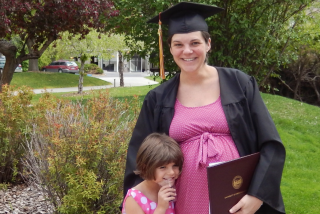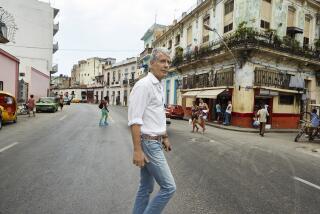Threepenny: State’s Biggest Little Literary Voice
My grandmother sat in her chair. She said, When I lie down at night I can’t rest, my bones push each other. When I wake up in the morning I say to myself, What? Did I sleep? My God I’m still here. I’ll be in this world forever.
Thus begins a story by award-winning short story writer Grace Paley that ran in an early issue of a Berkeley literary magazine called The Threepenny Review. In the review’s upcoming issue, its 7,500 readers will find a Susan Sontag essay on Italian photography, her first published writing on that art form since her 1977 book, “On Photography.”
Such pieces have made Threepenny the most famous of the dozen or so California-based journals and made Wendy Lesser, the 35-year-old redhead who founded the review in 1980, a kind of star among her literary peers.
“There has always been a good amount of writing in California but Threepenny has put California into the national literary scene,” said Alice Quinn, fiction editor of the New Yorker magazine and former poetry editor with publisher Alfred A. Knopf Inc.
Her comments echoed those of many in New York, still the center of the nation’s literary culture. “People are very aware of it, because it’s is exceptionally lively and pertinent,” said Gordon Lish, an editor at Random House.
Over lunch in the sort of Berkeley bistro where people sit with espressos while reading slim volumes of poetry, Lesser said she sought a national identity for her review from the day she put out the first issue with $10,000 saved from various jobs.
Raised in Palo Alto, Lesser’s ambitions stem from a background that includes a glamorous academic pedigree. After undergraduate years at Harvard, she studied literature for two years at Cambridge University in England, where she also worked for the British Labour Party, before returning to California.
Not long after finishing an English Ph.D. program at UC Berkeley, she started the review, naming it after “The Threepenny Opera” by Bertholt Brecht.
Lesser’s admiration for Brecht’s mix of social consciousness, an analytical mind and a thick skin tell a lot about her. Overflowing with bookish enthusiasms, without the stiff manner of the academic stereotype, she brings the same drive other members of her generation devote to making their fortunes to finding writers and getting them read. The magazine tends to be full of critical essays, poems and intimate narrative voices like Paley’s.
“My friends say that I tend to drive over life like a tank,” she said. “I tend to just go forward, to go after things and think more about it later . . . and I figure the magazine has survived not just because of its literary quality but also because I have some kind of business sense.”
She is at home discussing the direct-mail techniques as those of poetry, and has written
articles about both. Buying the subscriber list of The American Poetry Review, she got an unusually high 10% return. “I don’t think anybody thought of it,” she said. “It was a virgin list.”
Eked Out a Profit
Lesser does everything at Threepenny herself, besides the typesetting and printing, which she jobs out but still oversees closely. An hour with her at her typesetters is a lot like a visit to a small-town weekly newspaper, as she compares type styles and the placement of the drawings and prints that accompany the writing.
The tabloid-style magazine runs 28 to 32 pages and costs about $20,000 to produce. Lesser, whose husband writes plays and teaches at a local college, says Threepenny did a bit better than break even this year--no small feat in little-magazine publishing.
Working out of an office in a modest house on a quiet side-street, she became acquainted with Sontag through a contributor in Los Angeles; Lesser’s mother knows Paley.
Gore Vidal wrote for her after Lesser sent him a copy of an issue that contained a review of a novel he had published under a pseudonym. Lesser paid him $50, a typical amount at Threepenny and other reviews--many of which reward their writers with nothing more than free copies.
She recently raised a some dust among Bay Area literati with an opinion piece she wrote for the Washington Post suggesting that Bay Area literary organizations place too much value on the regional quality of their writers.
“I’m a second-generation California person and I think that there is no reason why serious intellectual activity can’t take place on the West Coast without labeling it exclusively West Coast or exclusively East Coast,” Lesser said during the interview. “I think it is provincial that there has to be a geographical label to what one thinks, because it’s the thinking that counts, and writing that goes beyond this time and place.”
Meanwhile, she draws upon the active literary life of Berkeley. Threepenny features many California-based writers, among them poets Robert Hass, Robert Pinsky and 1980 Nobel Prize laureate Czeslaw Milosz. It has included work by novelist Leonard Michaels, as well as that of relatively unknown short story writer Gilb Dagoberto, who moves between construction jobs in Los Angeles and El Paso to support his writing.
The summer, 1986, issue of Threepenny carried a critical essays on Merce Cunningham and the Sex Pistols, as well as poetry from emerging poet August Kleinzahler. It also had a long piece by a European writer about his mother:
From the age of five or six I was worried about the death of my parents. The inevitability of death was one of the first things I learnt about the world on my own. Nobody else spoke of it yet the signs were so clear.
Every time I went to bed--and in this I am sure I was like millions of other children--the fear that one or both of my parents might die in the night touched the nape of my neck with its finger. Such a fear has, I believe, little to do with a particular psychological climate and a great deal to do with nightfall.
Another piece was a memoir about the author’s experiences waitressing at Canter’s delicatessen in the Fairfax district of Los Angeles:
In most cases the uniforms were well-worn, with underarms stained an irreparable gray and hems which had been let up or down more than once. But their dominant characteristic was size. Most of the available uniforms could have doubled as small tents. And no matter how many pins or tucks you employed, material would bellow out over your tightly pulled apron strings, an irrepressible tribute to the amplitude of your predecessors.
The first writer was John Berger, an internationally regarded cultural writer best known, perhaps, for a book on Picasso. The Canter’s piece was by Irene Oppenheim, not a famous name but a Southern California critic whose work Lesser runs often. Both pieces have since been anthologized by small and university press publishers, and Lesser’s admirers say the blend of such work is what they like about her review.
“I think of a major writer as particularly generous to let a piece go where it does not have the circulation numbers, perhaps,” she said. “Even if everybody isn’t famous, they believe they will be in good company. They have faith in the character of the magazine.”
More to Read
Sign up for our Book Club newsletter
Get the latest news, events and more from the Los Angeles Times Book Club, and help us get L.A. reading and talking.
You may occasionally receive promotional content from the Los Angeles Times.






